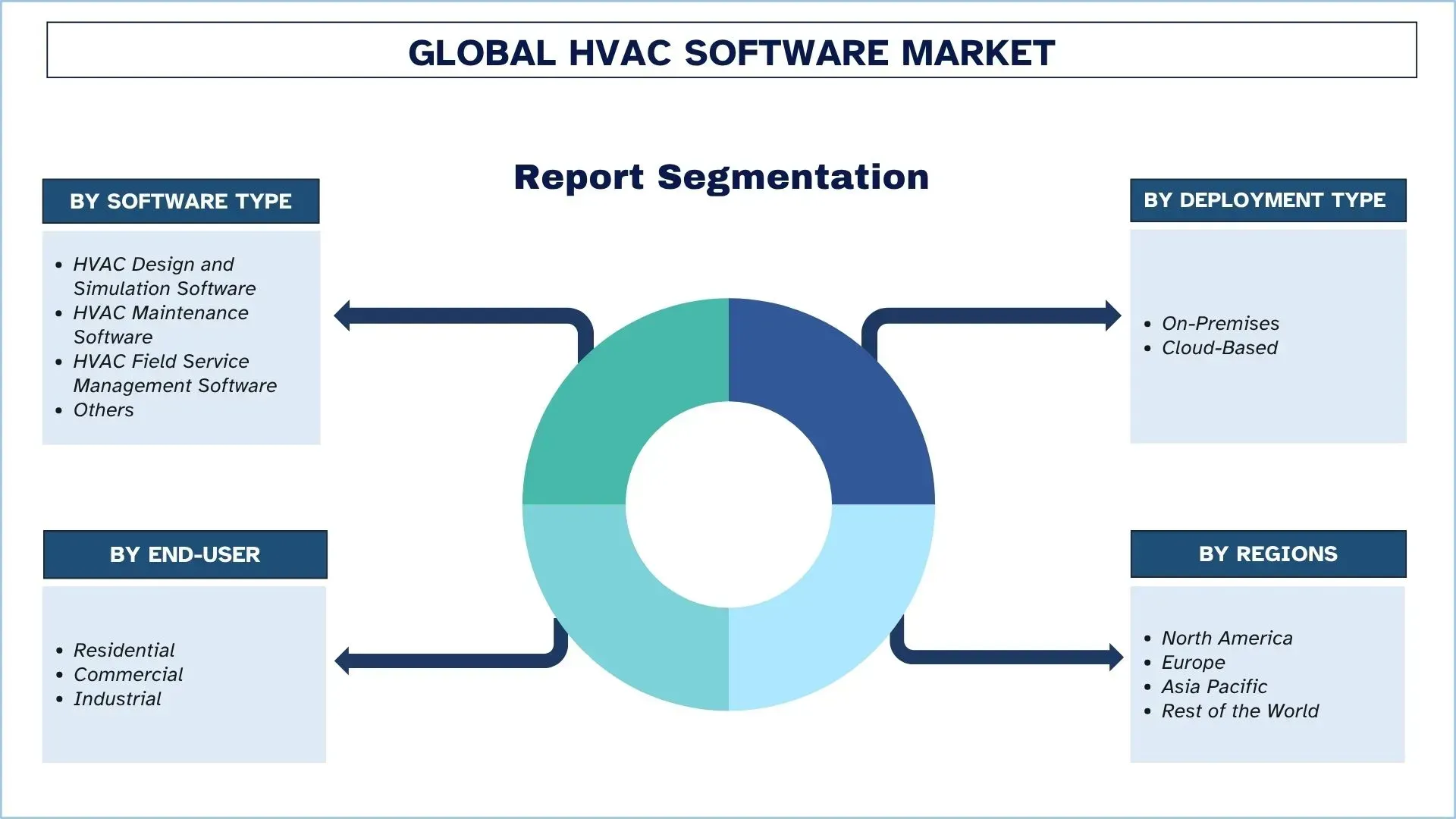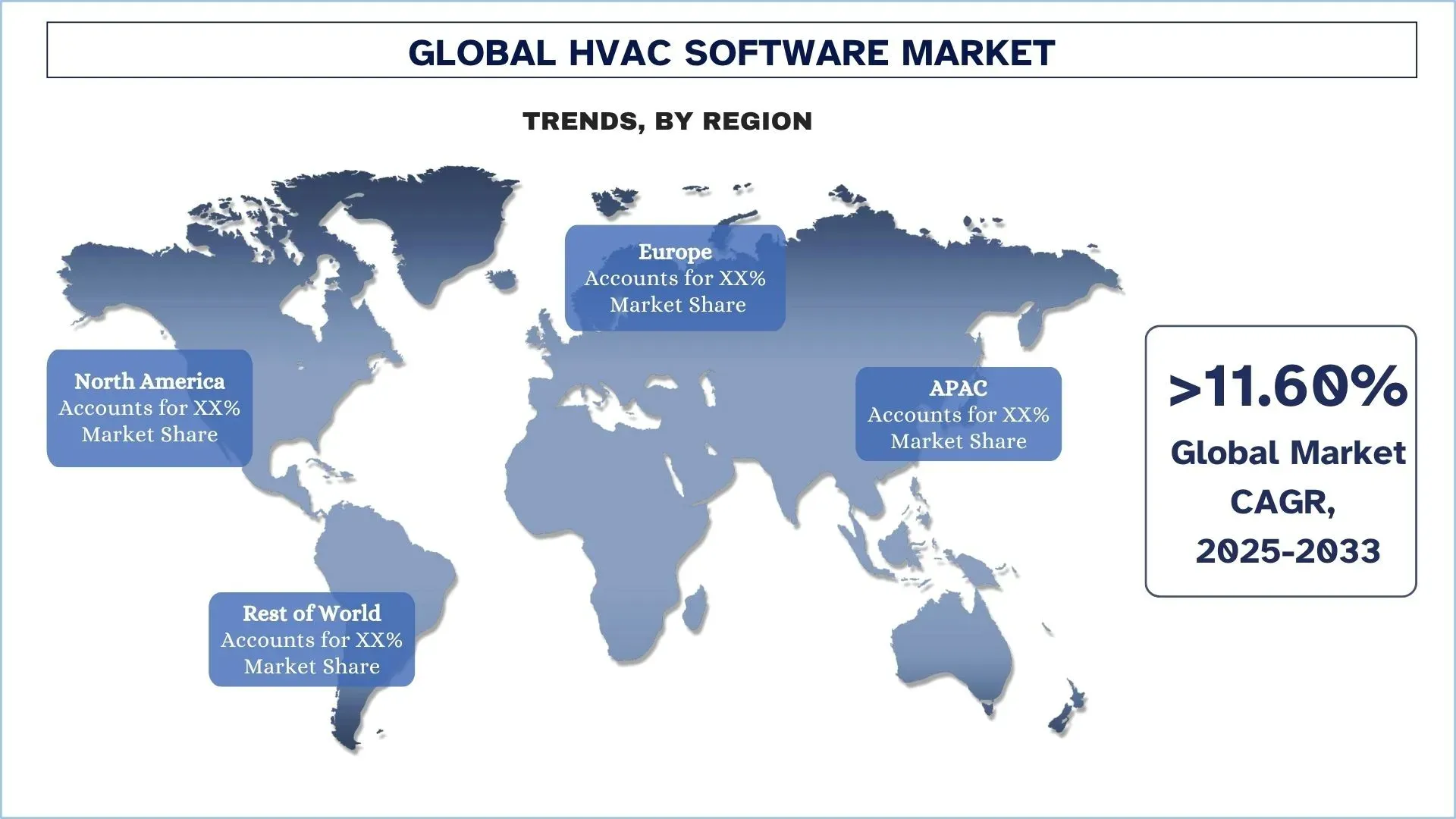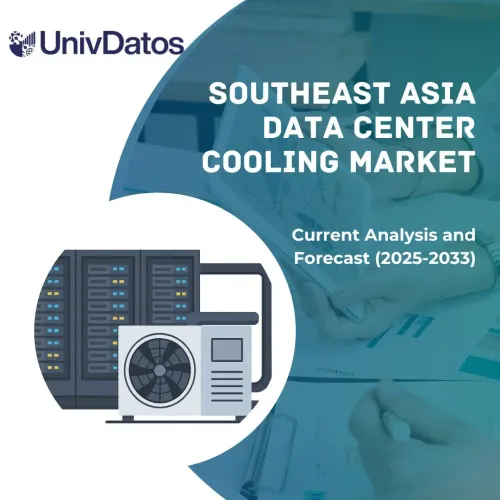- Home
- About Us
- Industry
- Services
- Reading
- Contact Us
HVAC Software Market: Current Analysis and Forecast (2025-2033)
Emphasis on By Software Type (HVAC Design and Simulation Software, HVAC Maintenance Software, HVAC Field Service Management Software, Others); By Deployment Type (On-Premises, Cloud-Based); By End User (Residential, Commercial, Industrial), and Region/Country

HVAC Software Market Size & Forecast
The HVAC Software market was valued at USD 1.65 billion in 2024 and is expected to grow at a strong CAGR of 11.60% for the forecast period (2025- 2033F) due to the introduction of smart technologies, energy efficiency, sustainability, and widespread move toward smart buildings.
HVAC Software Market Analysis
The primary reasons for the growth of the HVAC software market are the demand for energy-efficient buildings, the adoption of smart technologies, and the rise of environmental regulations. With businesses and homeowners facing increasing energy costs and sustainability becoming a globally recognized priority, HVAC software solutions help businesses to improve system performance and minimize energy usage. People hoping to make their home more sustainable can utilize the technology towards green building standards such as LEED, ENERGY STAR, and other ratings. Additionally, an influx of smart buildings, along with increased utilization of IoT solutions, AI, and cloud-based applications, has completely changed the management of HVAC installations, by allowing real-time monitoring and remote management along with predictive maintenance and data analytics.
HVAC Software Market Trends
This section discusses the key market trends influencing the various segments of the HVAC Software market as identified by our research experts.
The growing focus on indoor air quality (IAQ) drives the HVAC Software Market.
The growing focus on indoor air quality (IAQ) is driving the growth of the HVAC software market by increasing demand for smart systems that can monitor, analyze, and optimize air conditions in real time. With the increasing awareness of the detrimental health implications of poor air quality, building owners, facility managers, and even homeowners have begun investing in HVAC software solutions with IAQ sensors that monitor pollutants, humidity, CO₂, and ventilation efficiency. In addition, HVAC software allows for automated modifications to air volume and pressure, filtration, and temperature controls to establish healthy indoor environments without compromising safety or required standards. Further, the emergence of smart building technologies and IoT devices is creating additional opportunities to utilize HVAC software in even uncoupled air quality platforms.

HVAC Software Industry Segmentation
This section provides an analysis of the key trends in each segment of the global HVAC Software market report, along with forecasts at the global, regional, and country levels for 2025-2033.
The HVAC maintenance software dominates the HVAC Software market.
Based on software type, the market is segmented into HVAC design and simulation software, HVAC maintenance software, HVAC field service management software, and others. HVAC maintenance software is one of the leaders in the HVAC software category due to the crucial role maintenance services play in the lifespan, efficiency, and reliability of heating, ventilation, and air conditioning systems. The complexity and importance of HVAC systems in commercial and residential buildings have dramatically increased the need for proactive, data-driven maintenance. Maintenance software provides real-time monitoring of HVAC systems, connectivity to the Internet of Things (IoT) sensors and cloud platforms, automated service reminders, and predictive maintenance. With increased maintenance and service, customers can reduce the number of unexpected breakdowns and downtime and increase equipment life, which in turn leads to significant cost savings for building owners and equipment service providers.
The on-premises deployment category dominates the HVAC Software market.
Based on deployment type, the market is segmented into on-premises and cloud-based. Among these, the on-premises market held the largest portion of global revenue in 2024. Many large organizations and institutions, such as government institutions, healthcare hospitals/facilities, manufacturing plants, and educational campuses, are now controlling, securing, and customizing a full feature set of any energy management technology. On-premises solutions are installed directly into the organization’s infrastructure, which provides a high level of confidence and compliance with the internal and regulatory organization policies. Thus, on-premises deployment approaches remain the solution of choice for manufacturers and end-users valuing security, reliability, and customized integration options in the HVAC software market.
North America held a dominant share of the HVAC Software market in 2024
North America held the largest share of the HVAC software market due to its better technological infrastructure, adoption of digital solutions, and regulatory frameworks that promote energy efficiency and smart building management. Further, the mature construction and real estate sector, particularly for commercial and institutional buildings, invests heavily in HVAC software. Beyond cloud technology, the increasing use of cloud computing, IoT, and mobile technologies in the HVAC industry throughout North America is supporting cloud-based and predictive maintenance platforms across multiple use cases. The ability to rely on cloud platforms allows for real-time diagnostics to identify service needs and automate service scheduling remotely. Consumers are increasing the trend of residential smart HVAC technology and home automation to further drive its adoption in the residential HVAC sector.
The United States held a dominant share of the North American HVAC Software market in 2024
The United States held the dominant share of the HVAC software market owing to the strong technological base, an established HVAC industry with a skilled workforce, and rigorous energy efficiency mandates. The United States was one of the first nations to digitize its buildings controls systems, which are solely software-based monitoring, automation, and predictive maintenance. Moreover, regulatory standards from the US Department of Energy, ASHRAE, and ENERGY STAR® certification demonstrate HVAC software compliance and energy efficiency software as a strategic priority of the United States. Further, the U.S. has access to high-speed internet, cloud service delivery, and cellular technologies, which ease the deployment of cloud-based HVAC solutions and IoT-enabled solutions. The majority of the HVAC software providers, such as Trane Technologies, Lennox International, Honeywell, and many other companies, are established primarily in the United States.

HVAC Software Competitive Landscape
The HVAC Software Market is competitive and fragmented, with several global and international market players. The key players are adopting different growth strategies to enhance their market presence, such as partnerships, agreements, collaborations, new product launches, geographical expansions, and mergers and acquisitions.
Top HVAC Software Companies
The major players operating in the market are Honeywell International Inc., Siemens AG, Carrier Global Corporation, Trane Technologies plc, Daikin Industries, Ltd., Lennox International Inc., Mitsubishi Electric Corporation (Mitsubishi Group), Schneider Electric, Emerson Electric Co., and LG Electronics.
HVAC Software Market News
On February 21, 2025, Grundfos announced the launch of MIXIT, the HVAC solution at ACREX India, 2025. It aimed further to transform the energy efficiency into heating, ventilation, and cooling systems.
On August 27, 2024, BuildOps, one of the premier providers of all-in-one sales, service, and project management software for commercial contractors, announced a partnership with Bluon for equipment information and technical support for the HVAC industry.
HVAC Software Market Report Coverage
Report Attribute | Details |
Base year | 2024 |
Forecast period | 2025-2033 |
Growth momentum | Accelerate at a CAGR of 11.60% |
Market size 2024 | USD 1.65 billion |
Regional analysis | North America, Europe, APAC, Rest of the World |
Major contributing region | Asia-Pacific is expected to grow at the highest CAGR during the forecasted period. |
Key countries covered | U.S., Canada, Germany, United Kingdom, Spain, Italy, France, China, Japan, and India |
Companies profiled | Honeywell International Inc., Siemens AG, Carrier Global Corporation, Trane Technologies plc, Daikin Industries, Ltd., Lennox International Inc., Mitsubishi Electric Corporation (Mitsubishi Group), Schneider Electric, Emerson Electric Co., and LG Electronics. |
Report Scope | Market Trends, Drivers, and Restraints; Revenue Estimation and Forecast; Segmentation Analysis; Demand and Supply Side Analysis; Competitive Landscape; Company Profiling |
Segments Covered | By Software Type, By Deployment Type, By End User, By Region/Country |
Reasons to buy the HVAC Software Market report:
The study includes market sizing and forecasting analysis validated by authenticated key industry experts.
The report briefly reviews the overall industry performance immediately.
The report covers an in-depth analysis of prominent industry peers, primarily focusing on key business financials, product portfolios, expansion strategies, and recent developments.
Detailed examination of drivers, restraints, key trends, and opportunities prevailing in the industry.
The study comprehensively covers the market across different segments.
Deep dive regional-level analysis of the industry.
Customization Options:
The Global HVAC Software Market can be customized by requirement or any other market segment. Besides this, UnivDatos understands that you may have your own business needs; hence, feel free to contact us to get a report that completely suits your requirements.
Table of Content
Research Methodology for the HVAC Software Market Analysis (2023-2033)
We analyzed the historical market, estimated the current market, and forecasted the future market of the global HVAC Software market to assess its application in major regions worldwide. We conducted exhaustive secondary research to gather historical market data and estimate the current market size. To validate these insights, we carefully reviewed numerous findings and assumptions. Additionally, we conducted in-depth primary interviews with industry experts across the HVAC Software value chain. After validating market figures through these interviews, we used top-down and bottom-up approaches to forecast the overall market size. We then employed market breakdown and data triangulation methods to estimate and analyze the market size of industry segments and subsegments:
Market Engineering
We employed the data triangulation technique to finalize the overall market estimation and derive precise statistical numbers for each segment and sub-segment of the global HVAC Software market. We split the data into several segments and sub-segments by analyzing various parameters and trends, including software type, deployment type, end-user, and regions within the global HVAC Software market.
The main objective of the Global HVAC Software Market Study
The study identifies current and future trends in the global HVAC Software market, providing strategic insights for investors. It highlights regional market attractiveness, enabling industry participants to tap into untapped markets and gain a first-mover advantage. Other quantitative goals of the studies include:
Market Size Analysis: Assess the current forecast and market size of the global HVAC Software market and its segments in terms of value (USD).
HVAC Software Market Segmentation: Segments in the study include areas of software type, deployment type, end-user, and regions.
Regulatory Framework & Value Chain Analysis: Examine the regulatory framework, value chain, customer behavior, and competitive landscape of the HVAC Software industry.
Regional Analysis: Conduct a detailed regional analysis for key areas such as Asia Pacific, Europe, North America, and the Rest of the World.
Company Profiles & Growth Strategies: Company profiles of the HVAC Software market and the growth strategies adopted by the market players to sustain in the fast-growing market.
Frequently Asked Questions FAQs
Q1: What is the HVAC Software market's current size and growth potential?
The HVAC Software market was valued at USD 1.65 billion in 2024 and is expected to grow at a CAGR of 11.60% during the forecast period (2025-2033).
Q2: Which segment has the largest share of the HVAC Software market by software type?
HVAC maintenance software is one of the leaders in the HVAC software category due to the crucial role maintenance services play in the lifespan, efficiency, and reliability of heating, ventilation, and air conditioning systems.
Q3: What are the driving factors for the growth of the HVAC Software market?
• Introduction of smart technologies: HVAC systems are becoming ‘smart’ due to the introduction of IoT (Internet of Things) technologies, which enable real-time monitoring and optimized performance control. These smart systems not only improve energy efficiency but also offer economic advantages by reducing operational costs and preventing equipment breakdowns.
• Energy efficiency and sustainability: Technologies, including heat pumps and variable refrigerant flow systems (VRFs), can help to reduce energy consumption and carbon emissions. This is particularly relevant in an industrial context, where energy savings are vital to reducing operating expenses and meeting sustainability requirements.
• Widespread move toward smart buildings: Innovations such as AI-based sound processing, Bluetooth connectivity, and rechargeable batteries are making devices more effective and appealing for children.
Q4: What are the emerging technologies and trends in the HVAC Software market?
• Growing indoor air quality (IAQ) solutions: The growing focus on indoor air quality (IAQ) is driving demand for HVAC software that can monitor, analyse, and optimize air filtration, ventilation, and humidity levels in real time to ensure healthier indoor environments.
• Increased use of predictive maintenance: The increased use of predictive maintenance in the HVAC software market is a key trend, enabling systems to anticipate failures, reduce downtime, and optimize service schedules through real-time data analytics and machine learning.
Q5: What are the key challenges in the HVAC Software market?
• Differences in regulations between regions, and compliance with regulations: Differences in regulations between regions and the need for compliance present a challenge for the HVAC software market, as developers must adapt solutions to meet diverse local standards, building codes, and energy efficiency requirements across global markets.
• The design and implementation of systems pose technical and financial challenges: The design and implementation of HVAC software systems pose technical and financial challenges due to the complexity of integrating with existing infrastructure, the need for skilled personnel, and high upfront development or deployment costs.
Q6: Which region dominates the HVAC Software Market?
North America dominates the HVAC software market due to its early adoption of advanced technologies, strict energy efficiency regulations, widespread smart building initiatives, and a well-established HVAC industry infrastructure.
Q7: Who are the key players in the HVAC Software market?
Some of the Leading companies in HVAC Software are:
• Honeywell International Inc.
• Siemens AG
• Carrier Global Corporation
• Trane Technologies plc
• Daikin Industries Ltd.
• Lennox International Inc.
• Mitsubishi Electric Corporation (Mitsubishi Group)
• Schneider Electric
• Emerson Electric Co.
• LG Electronics.
Q8: What are the key investment opportunities in the global HVAC Software industry?
Key investment opportunities in the global HVAC software industry include cloud-based platforms, AI-driven predictive maintenance, smart building integration, mobile workforce solutions, and regional expansion in emerging markets like Asia-Pacific.
Q9: How are mergers, acquisitions, and brand collaborations shaping the HVAC Software landscape?
Mergers, acquisitions, and brand collaborations are shaping the HVAC software landscape by accelerating technological innovation, expanding market reach, and enabling integrated solutions through strategic synergies between software providers, OEMs, and smart building technology firms.
Related Reports
Customers who bought this item also bought










